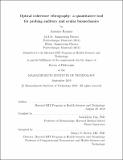| dc.contributor.advisor | Seok-Hyun Yun. | en_US |
| dc.contributor.author | Ramier, Antoine. | en_US |
| dc.contributor.other | Harvard--MIT Program in Health Sciences and Technology. | en_US |
| dc.date.accessioned | 2020-03-24T15:37:11Z | |
| dc.date.available | 2020-03-24T15:37:11Z | |
| dc.date.copyright | 2019 | en_US |
| dc.date.issued | 2019 | en_US |
| dc.identifier.uri | https://hdl.handle.net/1721.1/124268 | |
| dc.description | This electronic version was submitted by the student author. The certified thesis is available in the Institute Archives and Special Collections. | en_US |
| dc.description | Thesis: Ph. D., Harvard-MIT Program in Health Sciences and Technology, 2019 | en_US |
| dc.description | Cataloged from student-submitted PDF version of thesis. | en_US |
| dc.description | Includes bibliographical references (pages 137-155). | en_US |
| dc.description.abstract | Mechanical properties of biological tissues are inherently tied to their function. As such, they can provide direct insight into the structure and integrity of organs, and how they are affected by physiological and pathological processes. Optical coherence tomography (OCT) is a powerful imaging modality that can image the anatomy of biological tissues with near-cellular resolution. It can also be used to measure vibrations and deformations with nanometer-level sensitivity. This combination of tomography and vibrometry -- OCT vibrography -- forms a tool that is singularly positioned to quantify biomechanical behavior at the tissue scale. This thesis focuses on two promising fields of application for OCT vibrography: otology and ophthalmology. Sound-driven vibrations in the middle-ear ossicular chain and in the tympanic membrane are fundamental to hearing. Using the chinchilla ear as a model, we investigate the vibrational amplitude and phase as a function of sound frequency. Our 3-dimensional measurements reveal with unprecedented detail the modes of motion of the ossicular chain of an intact middle-ear. The ability of the cornea to focus light into a sharp image on the retina depends on its shape, which in turn is regulated by its mechanical properties. By measuring the velocity of mechanical waves, induced by an external stimulus and tracked using OCT vibrography, acoustic theory can be used to calculate the shear-elastic modulus of the corneal stroma. Our study demonstrates the first OCT-based quantification of corneal elasticity in live humans. | en_US |
| dc.description.statementofresponsibility | by Antoine Ramier. | en_US |
| dc.format.extent | 155 pages | en_US |
| dc.language.iso | eng | en_US |
| dc.publisher | Massachusetts Institute of Technology | en_US |
| dc.rights | MIT theses are protected by copyright. They may be viewed, downloaded, or printed from this source but further reproduction or distribution in any format is prohibited without written permission. | en_US |
| dc.rights.uri | http://dspace.mit.edu/handle/1721.1/7582 | en_US |
| dc.subject | Harvard--MIT Program in Health Sciences and Technology. | en_US |
| dc.title | Optical coherence vibrography : a quantitative tool for probing auditory and ocular biomechanics | en_US |
| dc.title.alternative | Quantitative tool for probing auditory and ocular biomechanics | en_US |
| dc.type | Thesis | en_US |
| dc.description.degree | Ph. D. | en_US |
| dc.contributor.department | Harvard--MIT Program in Health Sciences and Technology | en_US |
| dc.contributor.department | Harvard University--MIT Division of Health Sciences and Technology | |
| dc.identifier.oclc | 1145278786 | en_US |
| dc.description.collection | Ph.D. Harvard-MIT Program in Health Sciences and Technology | en_US |
| dspace.imported | 2020-03-24T15:37:10Z | en_US |
| mit.thesis.degree | Doctoral | en_US |
| mit.thesis.department | HST | en_US |
